We’d actually not planned on going to Odessa, the famous ex-soviet sea resort by the Black Sea, but since it is so close to Tiraspol, with less than a hundred kilometres in-between, we thought of giving it a go. Even though we aren’t really beach persons.

When we arrived, it was clear that the city was full of holiday makers. Trying to find a quieter spot, we headed eastwards from the centre, where rather soviet-style motels lined the beach front. Families in colourful summer attire were getting off the creaky trams and dragging their huge suitcases across broken, dusty pavement towards their holiday accommodation. The scene was reminiscent of some old Soviet movie.
We too had to find a place to settle, so we stopped by several hotels and guest houses to inquire about safe parking - we have enough loose stuff on our bikes (soft bags and three spare tyres) for it to be rather annoying to take everything off and carry to our room. Eventually, we went for a motel-style establishment right by the beach, which lacked any peace or idyll. It seemed to be occupied mostly by families, so children were running around with rather corpulent babushkas in bikini trying to watch after them. In the evening, the outdoor bar was loud with Russian pop music, so it was quite an experience. The parking conditions were almost adequate, though, and this is normally the first criteria that we take into consideration.
First, regardless of our pleas to park the bikes in the inner courtyard, we were asked to park them next to the security guard’s booth. The young guy who barely spoke Russian (we didn’t even try English), assured us that this was the safest place on earth. In the evening though, he was replaced by an older gentleman, who insisted that we park our bikes in the courtyard, off the view, because he was sure that by morning the tyres (as he said, those are hard currency in Ukraine) would otherwise disappear. Happily, we obliged.
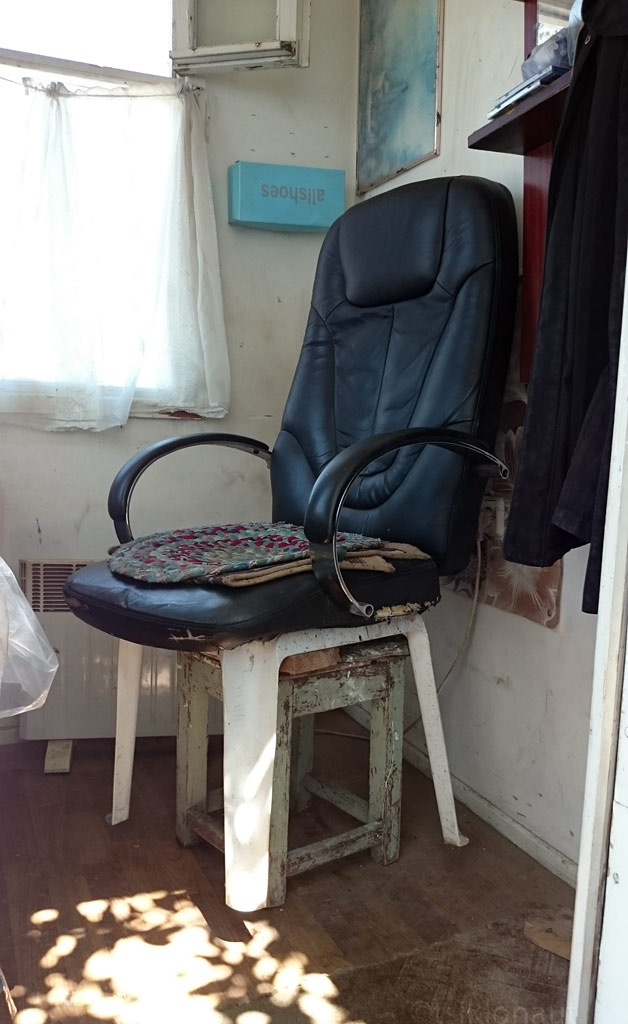
Our security guard's motto: "Why take one when you can use three!"
Even though we rather try to avoid the Sun rather than enjoy sunbathing, we went for a dip in the Black Sea. Not many people were swimming, actually, but the sand was tightly packed with people like sardines in a box, some in really weird positions in order to obtain seamless sun tan. If you’ve ever wondered if those pictures of beaches where there are unimaginably lots of people are real, I can assure you that this is no photoshop.
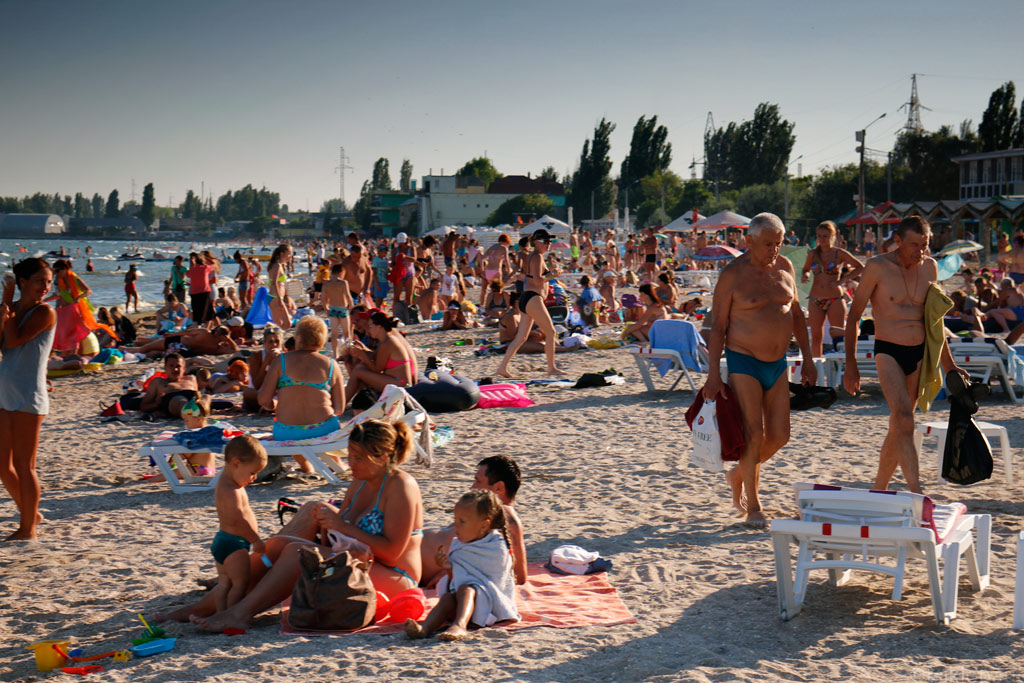

In late afternoon though, when the blaze is not so intense, the crowds dissipate, and you get some space to move.
Went out to the street to change some money, and took a few shots of not-so-central Odessa:
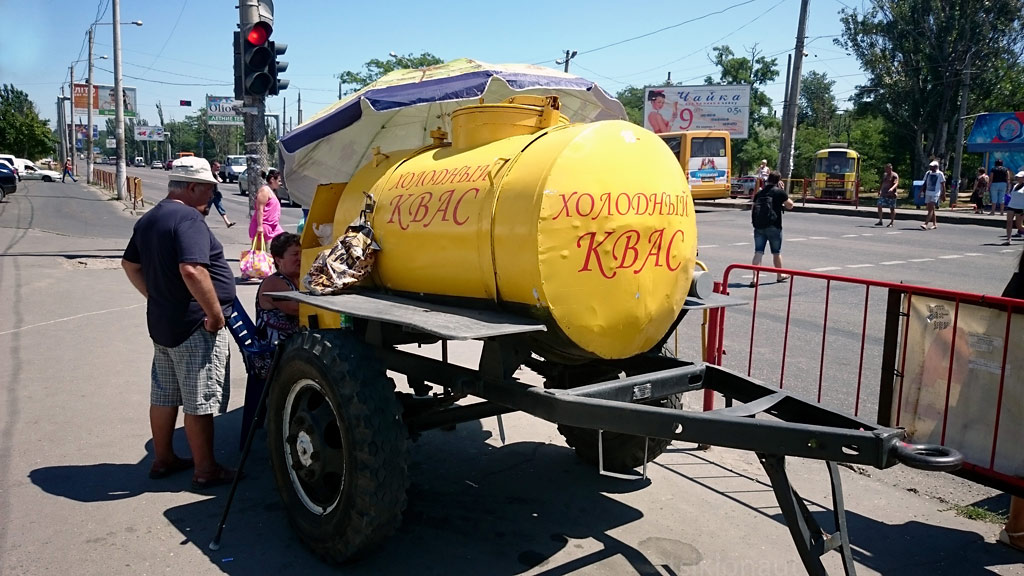
Another nostalgy element for us - cooled kvass on a truck cart. Got to tell you, this thing tastes real good in +30C weather!
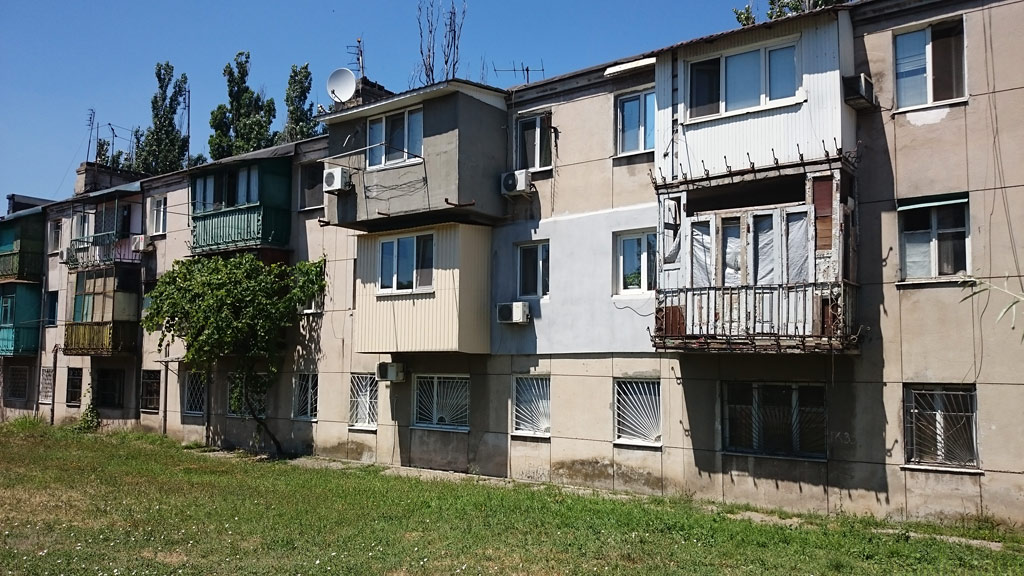
Odessa architecture is somewhat mixed, "slavic-village" style.
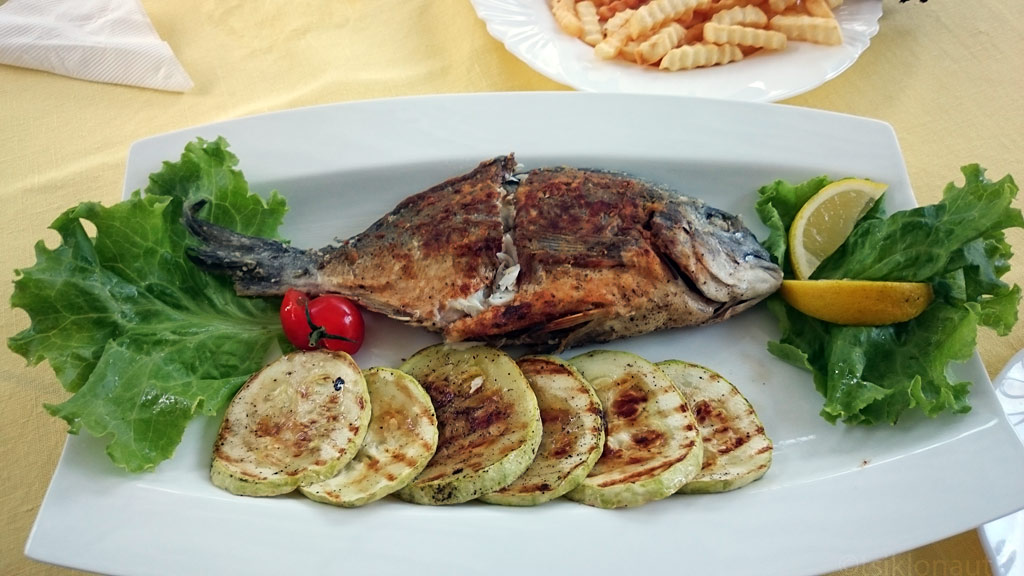
Then went out for dinner. A proper Odessan fish.
In the evening, when the sun had set, the beach was literally empty, but the atmosphere was delightful, with beautiful light and cool breeze.

The next morning we woke up quite early to the screeching sound of trams on the street, with half-a-sleep half-awake condition through a dreamy meditation it was like a wakeup call and instantly reminded us pictures from the legendary soundless film "Man With a Movie Camera" with a sound coming alive, since some of those movie scenes were shot in Odessa.
...:: Click to listen Odessa early morning soundscape ::...
Since we had to be at the ferry ticket office (meanwhile we’d decided to take the ferry from Odessa to Batumi, Georgia, rather than to ride to Georgia all the way back though Ukraine and then through Russia) at 9AM, we got up while everybody else still seemed asleep, made some coffee on the bathroom floor, ate some great with canned tuna, and packed our bags. Soon we were on our way to the harbour.
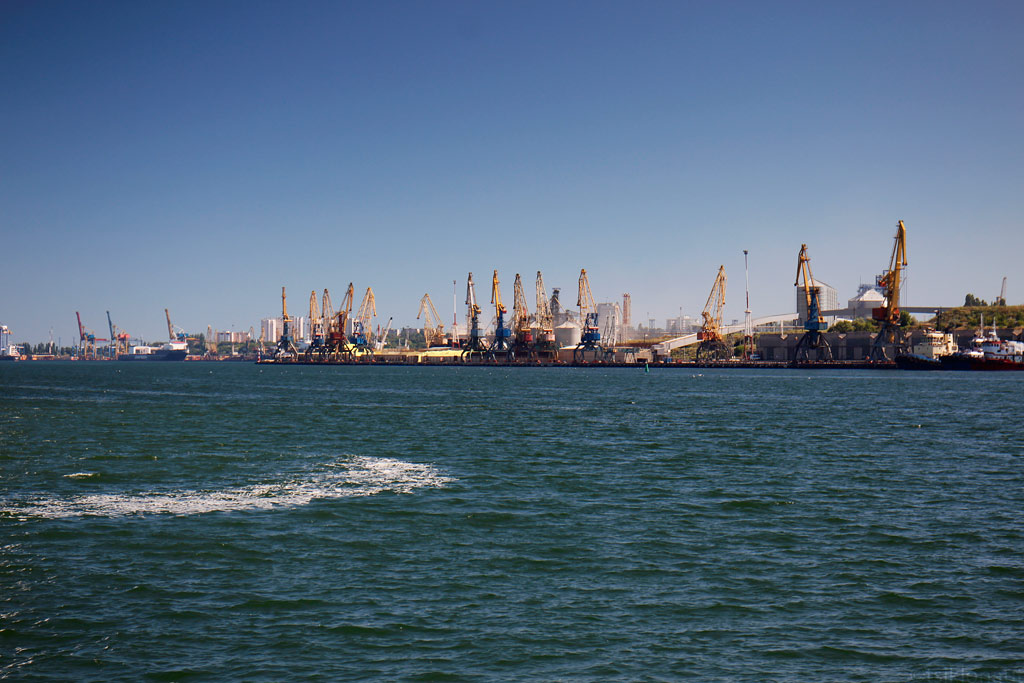
The traffic through the city was exhausting. Not only were many divers quite aggressive, but there were lots of tram rails that required added attention not to slip and fall over. After an hour or so of riding in the ever hotter streets we finally arrived at the ticket office, where Kariina spent some half an hour running between three different lockets before she got her hands on our tickets. We had booked them before, but weren’t quite sure if they were actually booked or not, as communication with the ticket agent had been somewhat laconic, not to say rude on their behalf. But all in all, we got our tickets, having paid 110 USD per person and 150 USD per bike, and were told to be at the ferry terminal at 2PM.
After a long wait to have our tickets registered (first, the passengers without vehicles were processed) we were finally allowed in the port territory, where we were ushered to the “ecological control”. To pass the check we had to produce copies of both out passports and bikes’ registration papers, which required some running around, because we lacked the latter. The ladies at the accounting office were more than reluctant to make any copies, but somehow we got there.
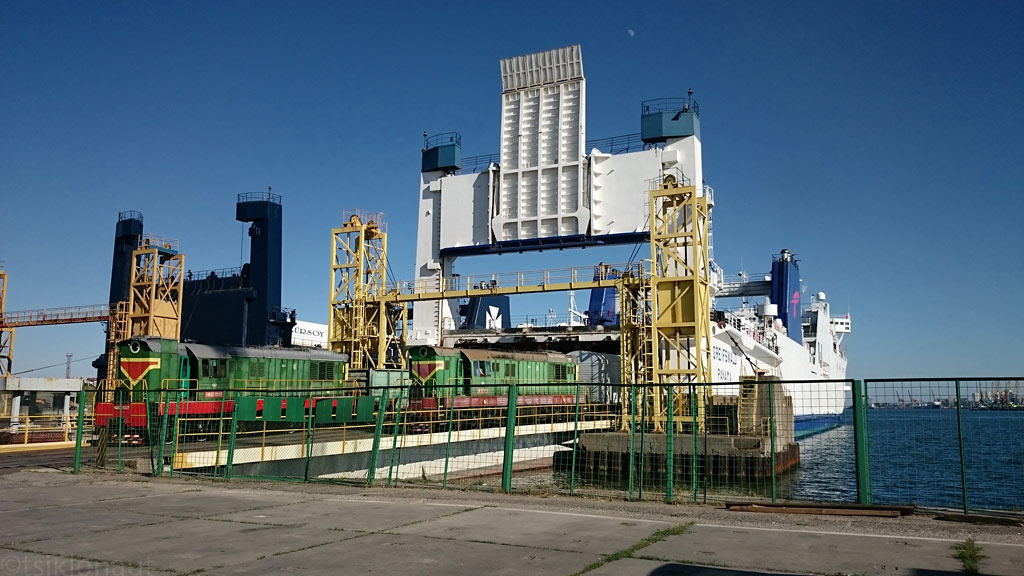
Railroad doesn't end with a sea! First time we saw ferry has 4 pairs of rails on the deck and syncs up with the dock so precise the trains can go on and in incredible amounts of wagons fit in.
..:: Click to listen soundscape on trains pushing into the ship ::..
After the ecology check, it was time to go to the customs, which turned out to be a very long story. Some Azerbaijani attaché who’d arrived with the ferry in the morning was stuck trying to import a car whereas he’d imported one before and hadn’t taken that one out of the country, so it was a major problem. So the whole bunch of people trying to get on the ferry with their vehicles were waiting after that guy. The young customs lady was very polite and was trying best to make things work out, whereas at one point the VIP already started mumbling something about a political scandal. And the crowd waited. For hours on end. At around 8PM we got cleared by the customs, went through the very thorough check (had to open every bag and pannier), then passport control, and then we could board the ferry. The cars and bikes had to be loaded later though, when all the cargo was on board, which may have been around 11PM. And so our ride across the Black Sea (which is in fact quite deep in some places, over 2000 meters) could begin!
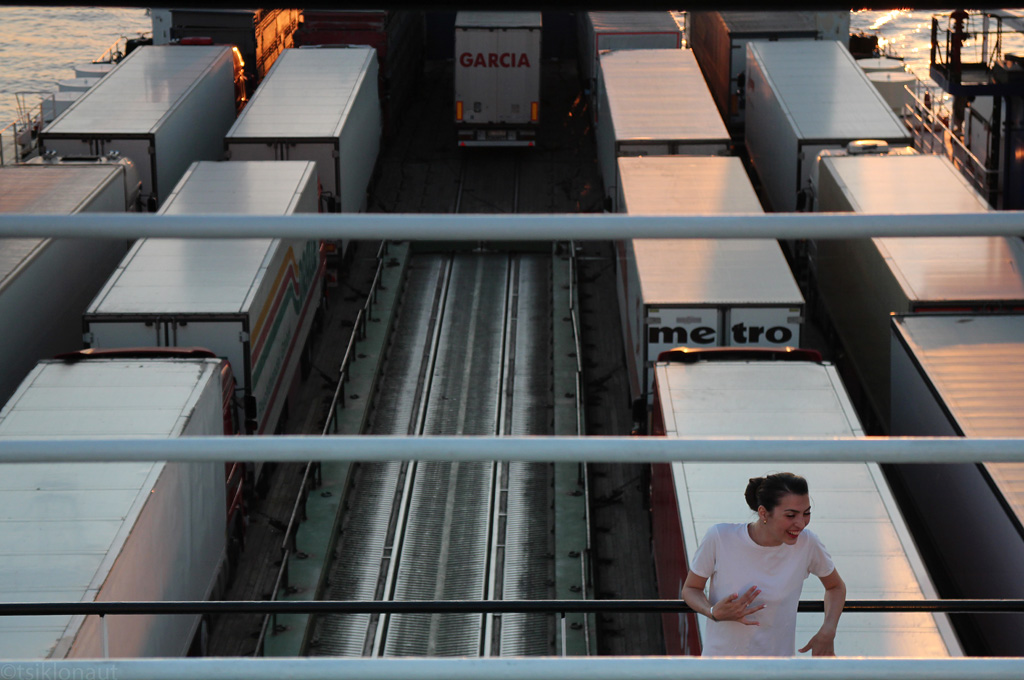
Train was loaded mostly with trucks and trains. Thus the crowd was mostly masculine (truck drivers and mechanics), but naturally the few young ladys among the passangers did get lots of attention.
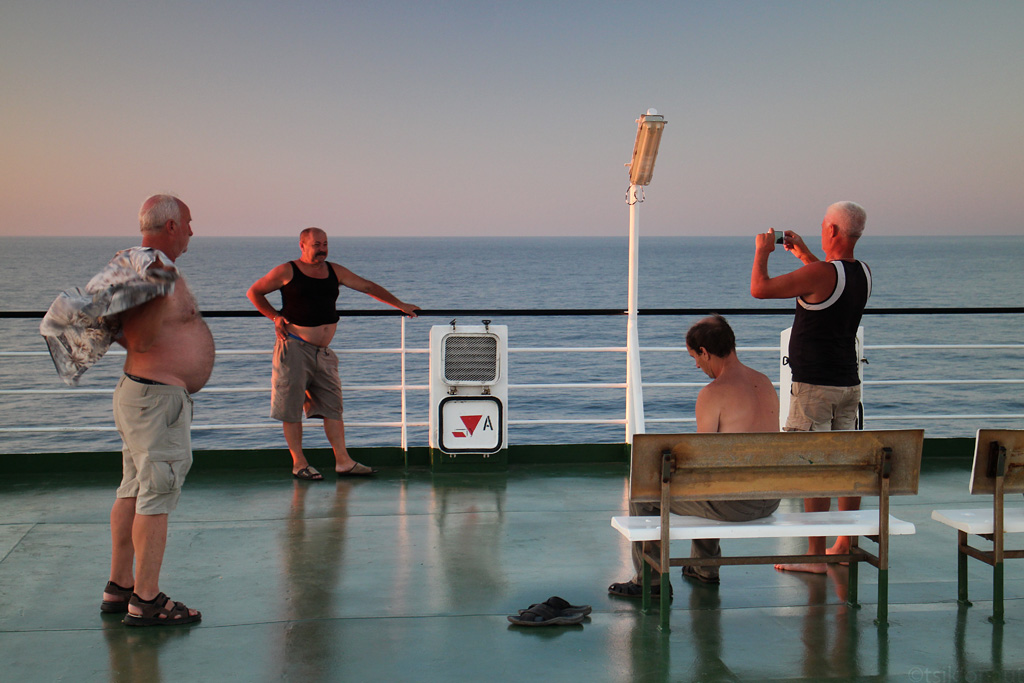
Truck drivers enjoying the voyage over the Black Sea.

Crimea, Russian war ship escorted us all the way to open waters for hours and hours. I guess we were too close to their waters for their liking. We could only wonder how many target practice sessions they simulated on us...
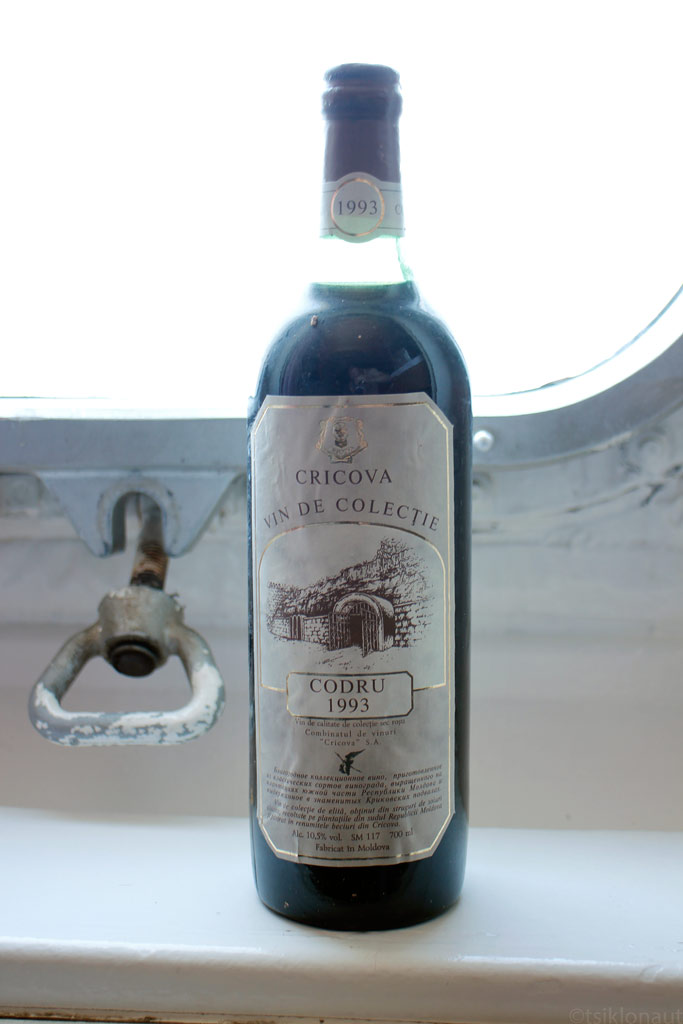
To ease the 48 hours of waiting time we had our last bottle of 1993 Cricova wine from the tour in the factory.

Sailing the Black sea...
And a video from Odessa to Batumi ferry (click full screen and HD mode for better view)
Our arrival in Batumi, Georgia, was like in a fairy tale - the Sun was just about to set into the Black Sea as our ferry slowly manoeuvred into the harbour. The ultra modern buildings lining the waterfront reflected the burning red of the setting Sun and on the backdrop, bluish clouds hang above the mountains. Couldn’t have expected a more scenic introduction.
Getting off the ferry took some time, though. First, all passengers had to go through immigration and customs, temporarily set up in the ship’s canteen. But even then it took several hours before were allowed to roll off the ferry, so it was well past midnight when we were finally released into the rushy traffic of the city. Batumi wasn’t sleeping at all - in fact, it was teeming with life just as if it were daytime. No wonder they call it the summer capital of Georgia.
We tried to find a place to spend the night, but the more affordable places were all locked up, and the more expensive ones were just too expensive for us. We decided to head out of the city, hoping to find something cheaper there, but we were faced with similar issues. Eventually, we rode our bikes up some rather steep track and set camp just aside it, next to an improvised trash pile. We were too exhausted to be picky and simply needed a place to lay our heads. After all, trying to find a perfect camping spot in the dark is like looking for a needle in a hay stack. Especially in a landscape that you are not familiar with.
It was difficult to fall asleep as we were over exhausted, but as we finally did, it was already morning and we had to get moving. We’d barely slept a few hours, so in order to clear our heads we first headed to some gas station spending there at least an hour munching on microwaved hot dogs and imbibing coffee in order to regain consciousness. In Georgian traffic, one needs every bit of attention and alertness as it can be quite a bit chaotic.
One more thing that needed getting used to was the heat. To allow for smoother adaption, we first headed into the Caucasus mountains in the north.
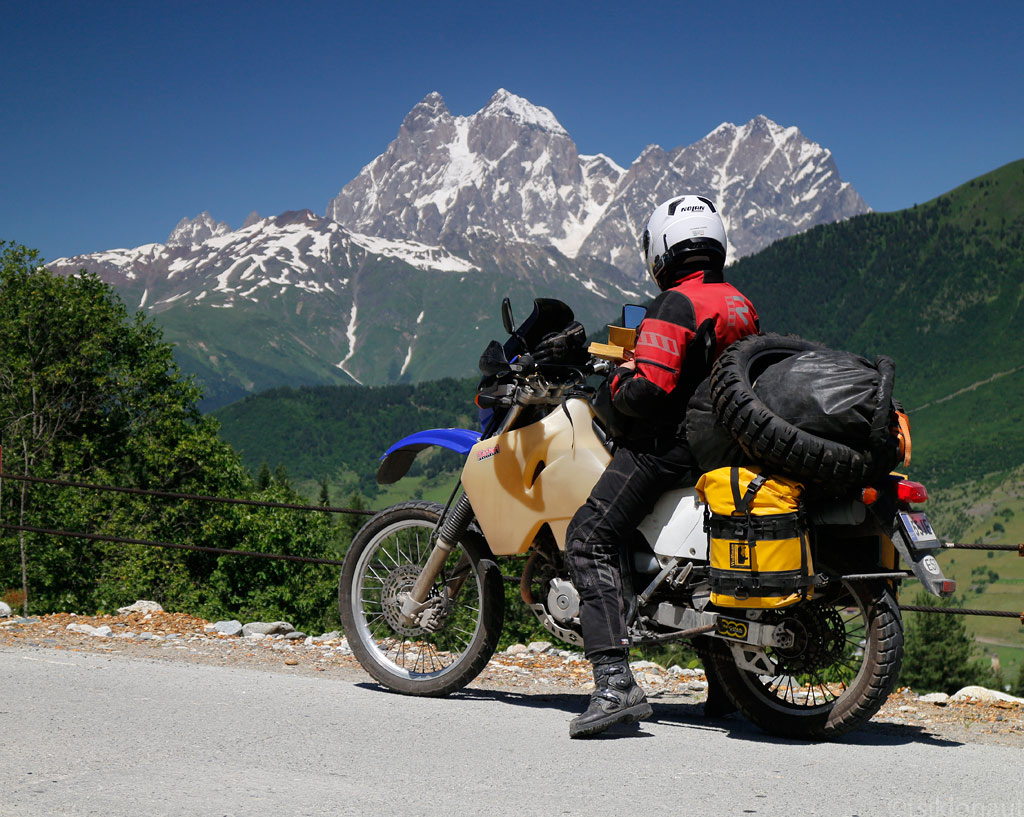
Škhara, the highest peak in Georgia.
The region of Svaneti is not only known for the gorgeous mountain scenery (one slightly tipsy truck driver on the ferry very emotionally described it as the most beautiful thing we’d ever see), but also for koshkebi, or tall defensive towers, counting over one hundred. Although geographically quite isolated, the area has seen many blood feuds, so those towers used to be the place to hide one’s family in times of trouble. Apparently it must have been quite difficult to get in as the entrances are located well above the ground, so a ladder is required.
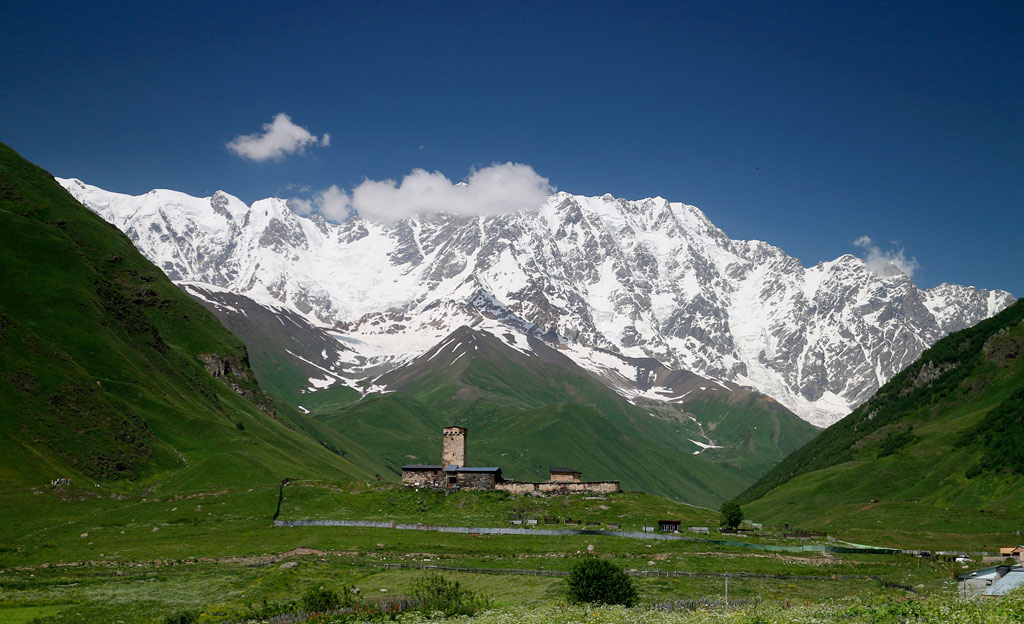
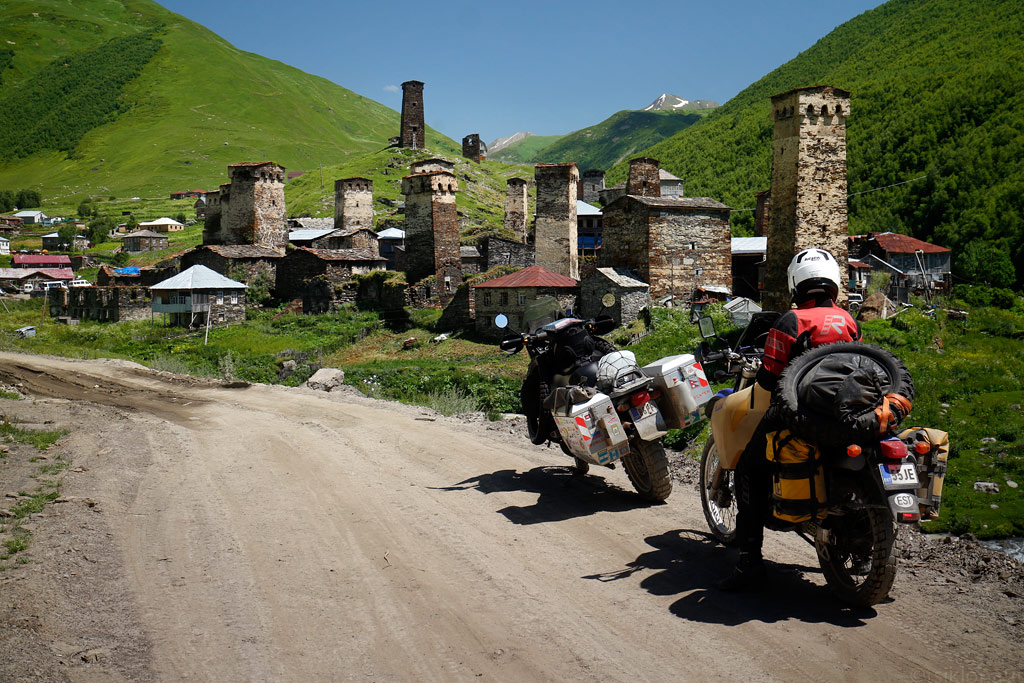
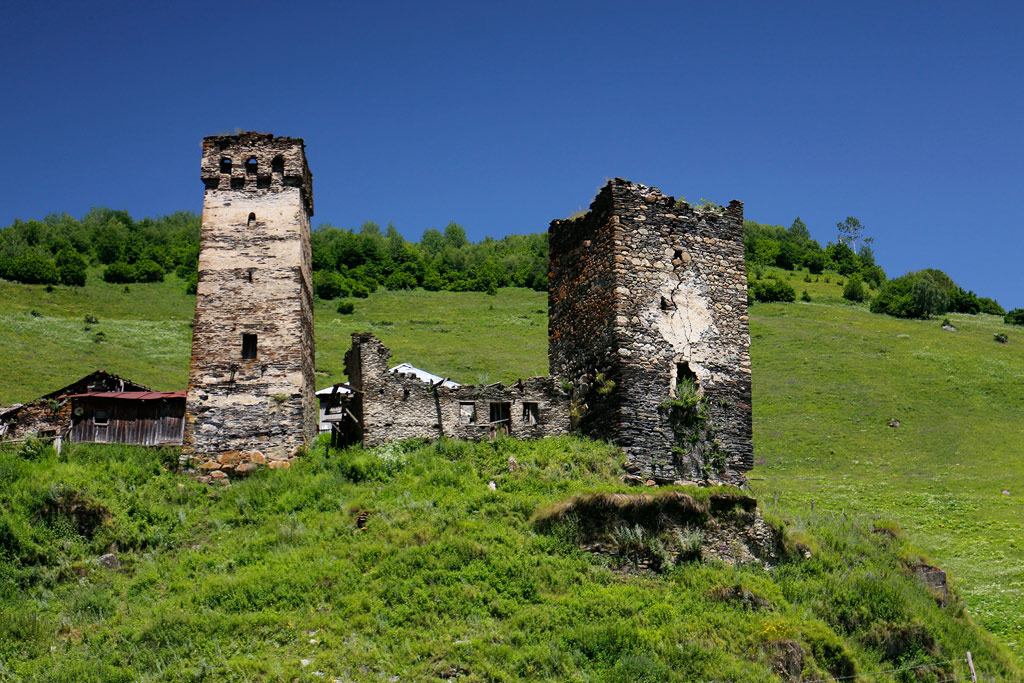

Panorama from Mestia village.
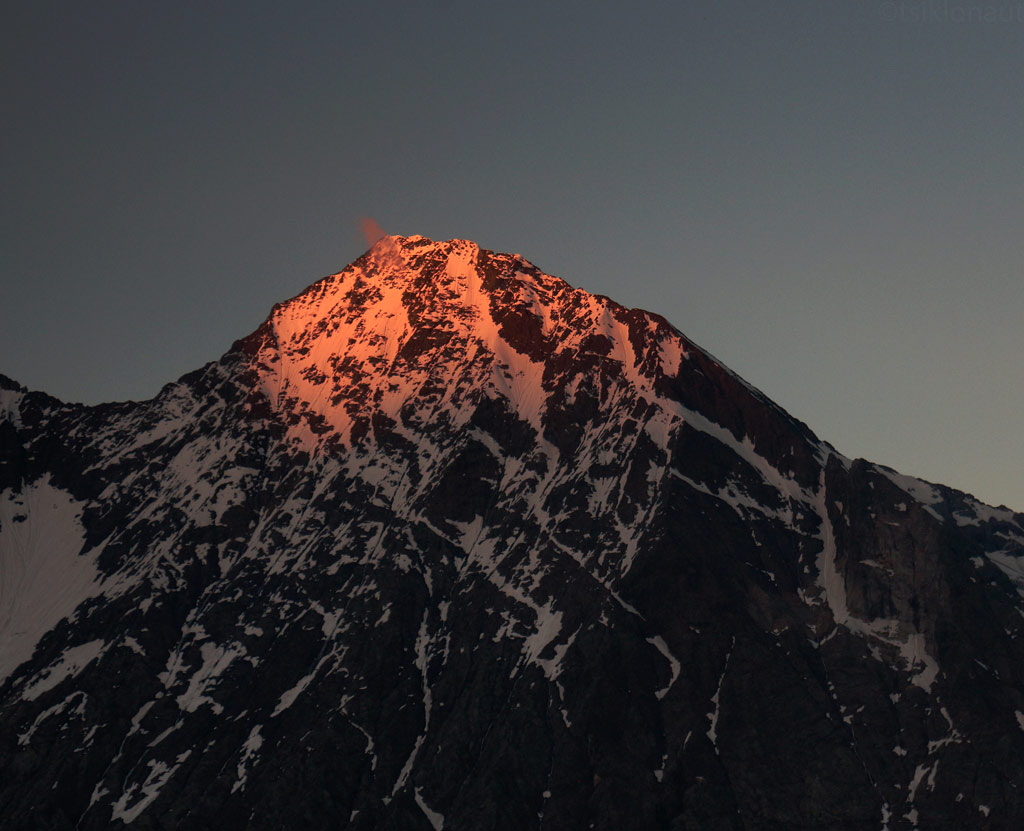
Peak Ušba.
Although the area definitely holds a lot of potential as a tourist destination, even in the village of Mestia, the apparent centre of the action, we saw very little foreign tourists. Local tourists seem in abundance though.
From Mestia we had to two options for moving on - either returning the way we’d come, or continuing to the village of Ushguli and from there down a track to Lentekhi. As backtracking rarely feels like an attractive option, we decided for the latter one, even though we were unsure if the track was doable by bikes - the information we’d gotten from locals was quite controversial.
The track proved to be quite rocky, but the landscapes made up for the roughness. At one point we noticed a cattle track running off the main track, and up a hill. We decided to check it out, and at the end of it found a place with a splendid view. Without giving it a long thought, we knew that this would be the perfect spot to spend the afternoon, so we pitched our tent.

Our camping spot at 2700 meters above sealevel aside a little abandoned chapel. Except the bears and wolves there's nobody around for dozens of miles radius!
...:: Click to listen the soundscape from the same spot ::..
There is a great number of churches and monasteries that hold a long history in Georgia. Surely we were not going to visit all of them, but we chose a few to take a look at. Most of them are located in scenic places, and Sapara monastery is no exception. Dating back to the 9th century, this monastery located in the region of Samske-Javakheti, is quaintly nestled in densely forested hills, and therefore somewhat isolated. Unfortunately, taking pictures is not permitted inside, but the colourful, detailed frescoes dating back to the 14th century are quite remarkable.
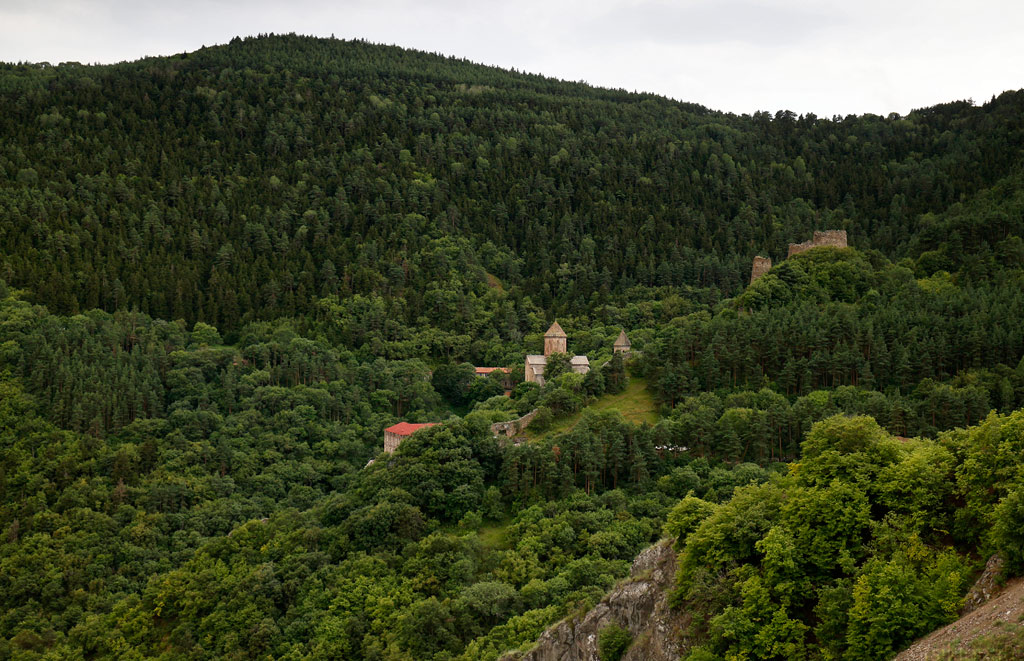
Sapara monastery is in a very symbiotic setting within the nature.
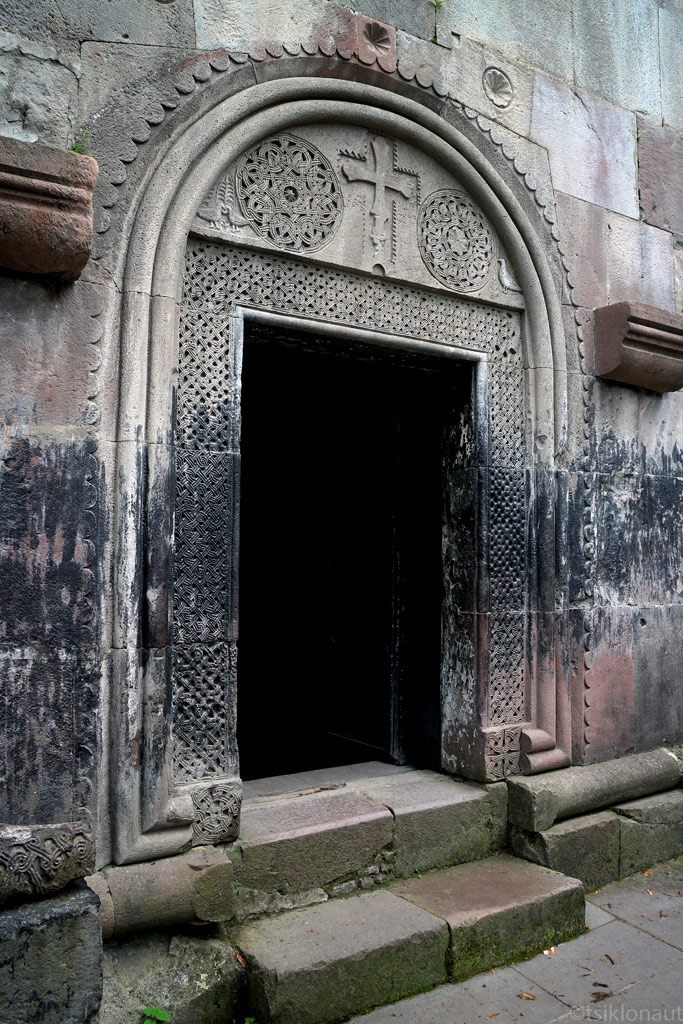
Doorway, photographing inside is strictly forbidden.
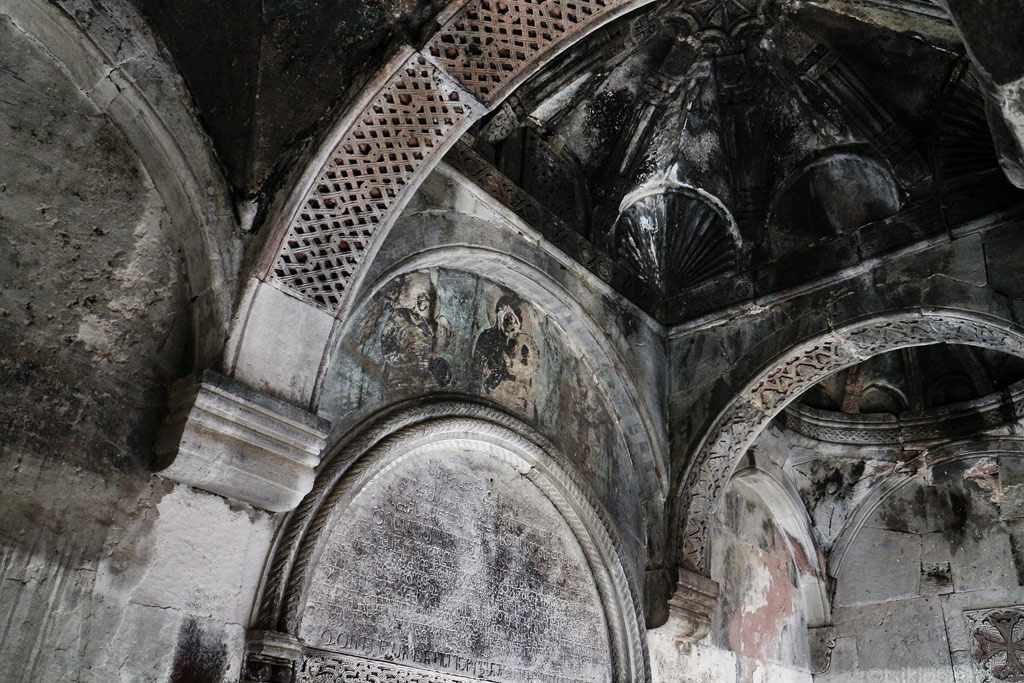
One of the outer domes.
...::: Click to listen to a monk's chant in Sapara monastery :::...
After we’d paid a visit to the monastery it was already quite late, so we decided to find a spot to pitch out tent in the nearby pine forest. The views on the landscape were great.
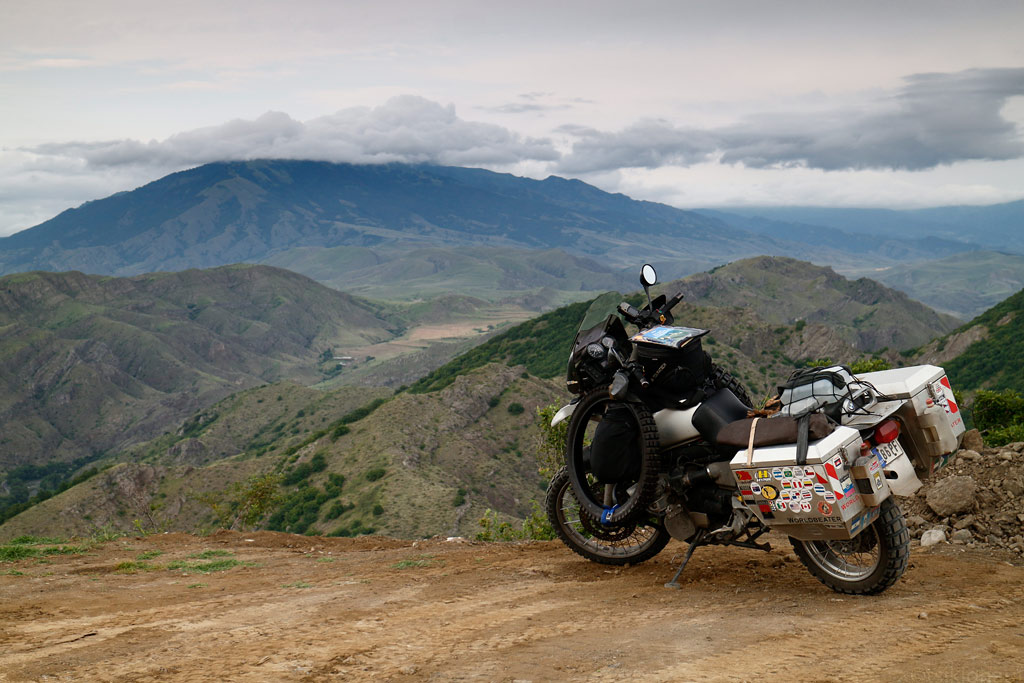

The Lesser Caucasus panorama from our wild camping spot.
The next day we had intended to go see the famous one thousand year old cave city of Vardzia, but missed the turnoff, only realising it around 30 kilometres down the road. Not very keen on backtracking, we turned to our GPS that suggested another road. Surely it was in quite an appalling condition, so partly, we rode the horse carriage track running next to it. At one point we came to a village, from where a steep, rocky track descended to the bottom of a canyon on the opposite side of which we could see the crumbled walls of Vardzia.
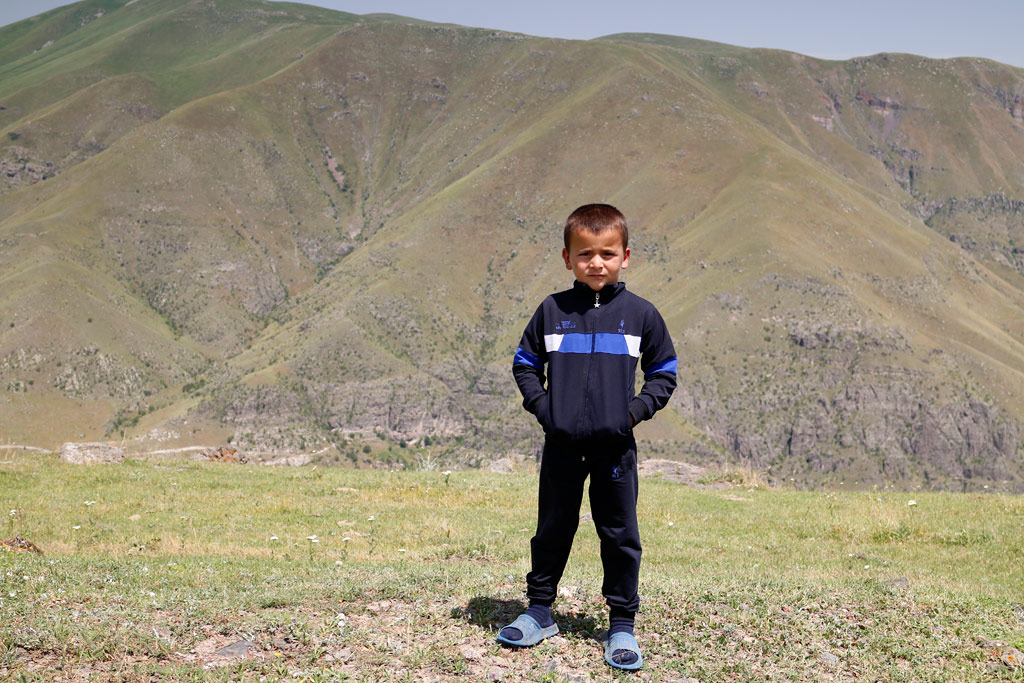
Herder boy observing us curiously.
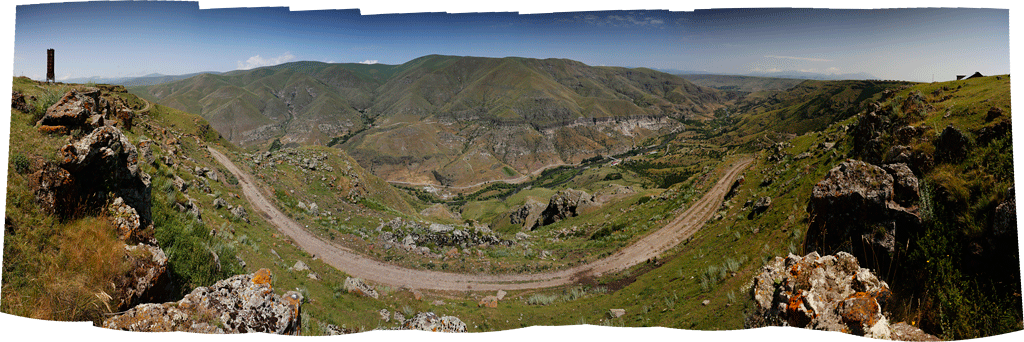
Steep road down to Vardzia (you can see the pale rock-face on the below right opposite valley) - interestingly almost no one takes this rough rocky long track there, we did it and it's worth it. You get that rare non-touristy "angle" to Vardzia.
The cave city itself is remarkable in the sense that it comprises more than ten floors of “rooms” carved into sand stone, in total counting a few hundred. In its heyday, there used to be a bakery, a pharmacy, wine cellars, and of course, a church. In 1283, an earthquake hit the city, crumbling its outer wall.
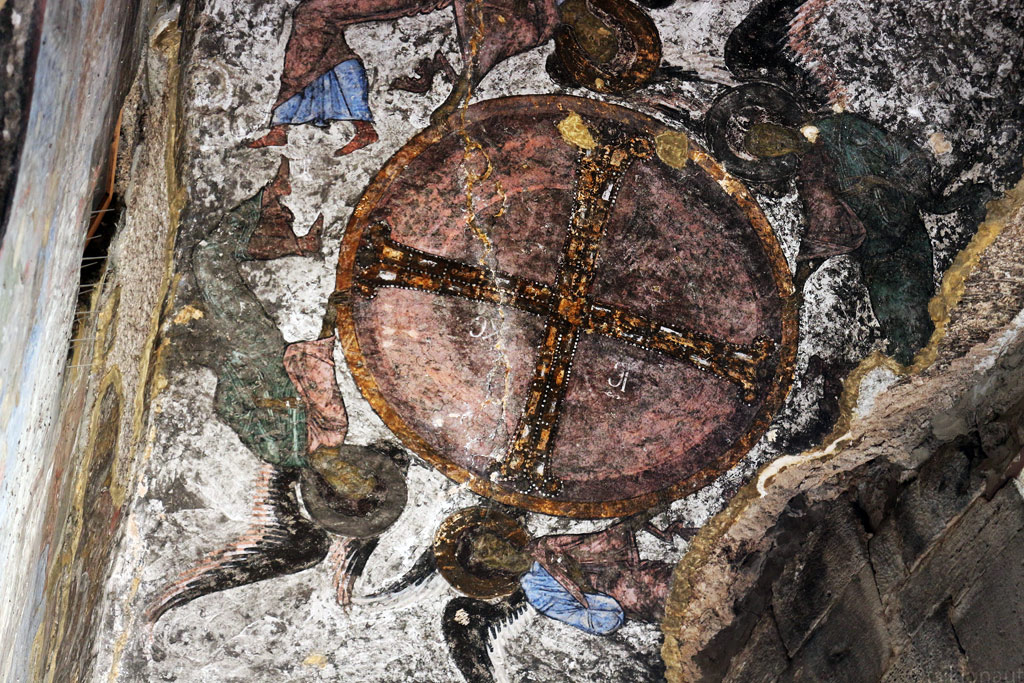
Ancient murals in Vardzia's walls and ceilings.
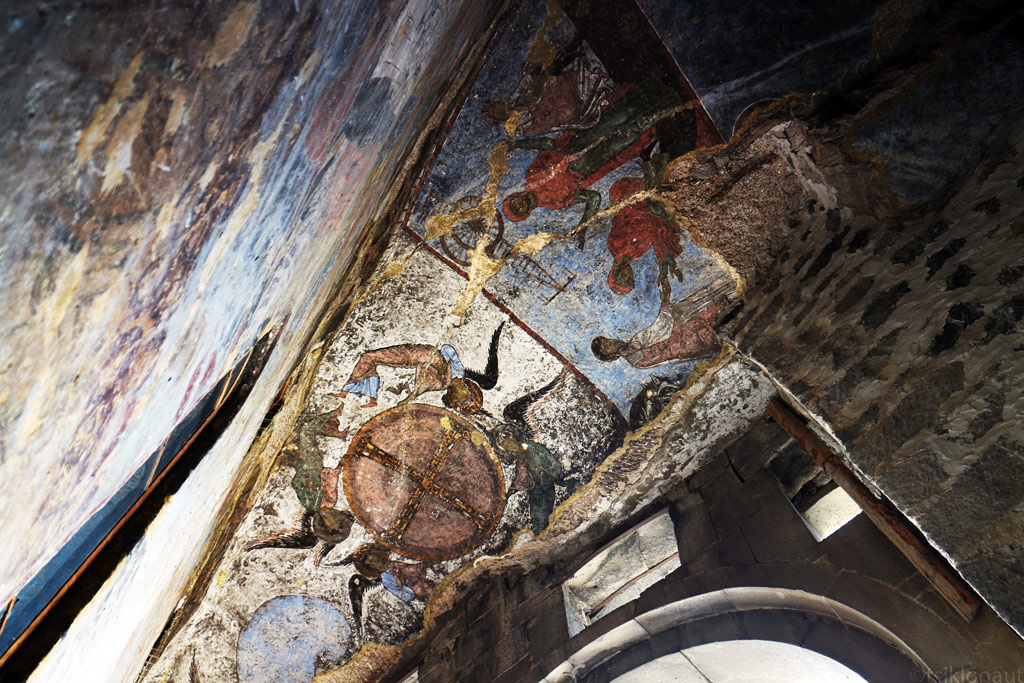
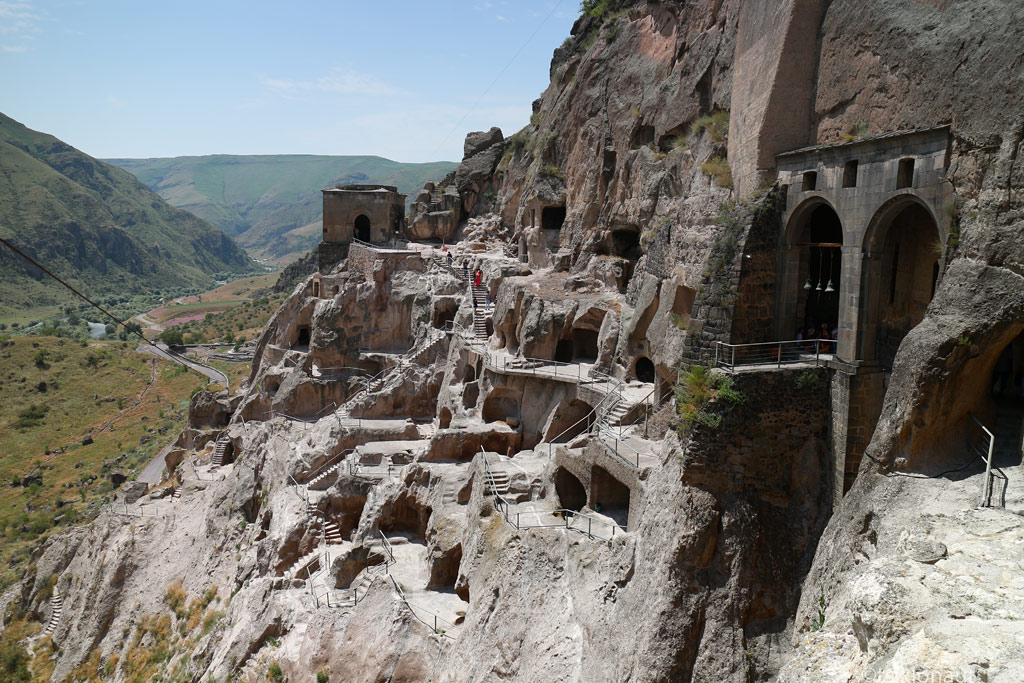
Vardzia's outer shell was actually collapsed down the mountain during a massive earthquake in the year 1283 - it used to be a Christian cave city with near-vertical wall near a millenia ago.
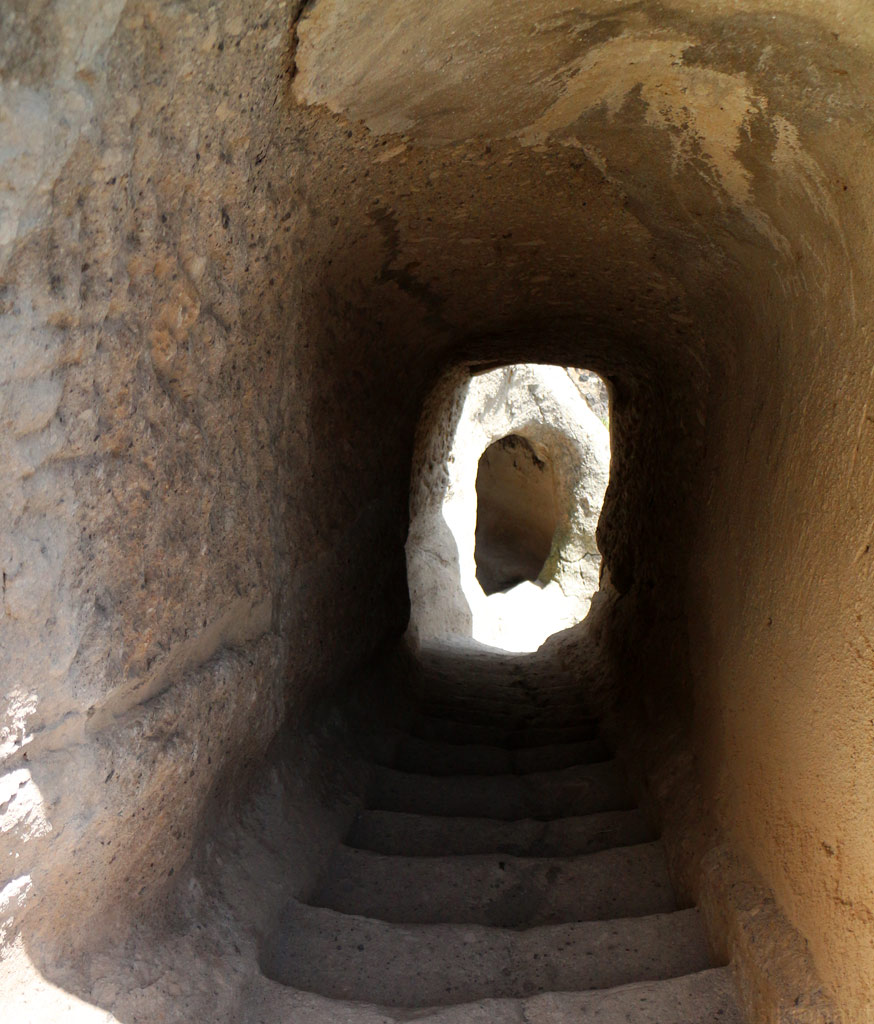
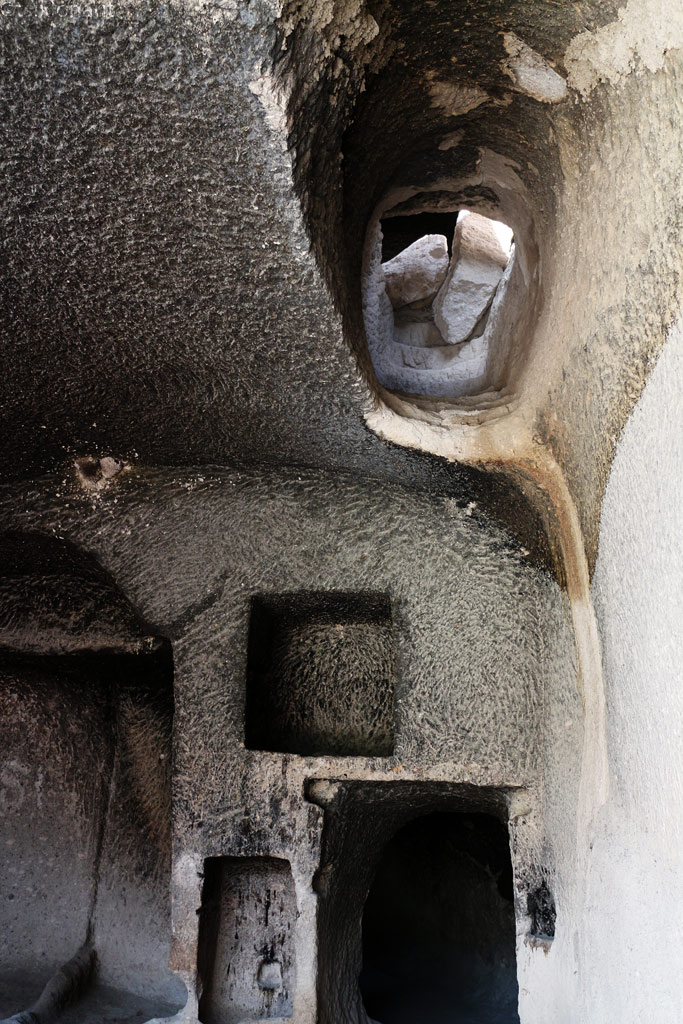
Pathways, often go from awkward angles. Inspiring actually.
Cheers,
Margus

When we arrived, it was clear that the city was full of holiday makers. Trying to find a quieter spot, we headed eastwards from the centre, where rather soviet-style motels lined the beach front. Families in colourful summer attire were getting off the creaky trams and dragging their huge suitcases across broken, dusty pavement towards their holiday accommodation. The scene was reminiscent of some old Soviet movie.
We too had to find a place to settle, so we stopped by several hotels and guest houses to inquire about safe parking - we have enough loose stuff on our bikes (soft bags and three spare tyres) for it to be rather annoying to take everything off and carry to our room. Eventually, we went for a motel-style establishment right by the beach, which lacked any peace or idyll. It seemed to be occupied mostly by families, so children were running around with rather corpulent babushkas in bikini trying to watch after them. In the evening, the outdoor bar was loud with Russian pop music, so it was quite an experience. The parking conditions were almost adequate, though, and this is normally the first criteria that we take into consideration.
First, regardless of our pleas to park the bikes in the inner courtyard, we were asked to park them next to the security guard’s booth. The young guy who barely spoke Russian (we didn’t even try English), assured us that this was the safest place on earth. In the evening though, he was replaced by an older gentleman, who insisted that we park our bikes in the courtyard, off the view, because he was sure that by morning the tyres (as he said, those are hard currency in Ukraine) would otherwise disappear. Happily, we obliged.

Our security guard's motto: "Why take one when you can use three!"
Even though we rather try to avoid the Sun rather than enjoy sunbathing, we went for a dip in the Black Sea. Not many people were swimming, actually, but the sand was tightly packed with people like sardines in a box, some in really weird positions in order to obtain seamless sun tan. If you’ve ever wondered if those pictures of beaches where there are unimaginably lots of people are real, I can assure you that this is no photoshop.


In late afternoon though, when the blaze is not so intense, the crowds dissipate, and you get some space to move.
Went out to the street to change some money, and took a few shots of not-so-central Odessa:

Another nostalgy element for us - cooled kvass on a truck cart. Got to tell you, this thing tastes real good in +30C weather!

Odessa architecture is somewhat mixed, "slavic-village" style.

Then went out for dinner. A proper Odessan fish.
In the evening, when the sun had set, the beach was literally empty, but the atmosphere was delightful, with beautiful light and cool breeze.

The next morning we woke up quite early to the screeching sound of trams on the street, with half-a-sleep half-awake condition through a dreamy meditation it was like a wakeup call and instantly reminded us pictures from the legendary soundless film "Man With a Movie Camera" with a sound coming alive, since some of those movie scenes were shot in Odessa.
...:: Click to listen Odessa early morning soundscape ::...
Since we had to be at the ferry ticket office (meanwhile we’d decided to take the ferry from Odessa to Batumi, Georgia, rather than to ride to Georgia all the way back though Ukraine and then through Russia) at 9AM, we got up while everybody else still seemed asleep, made some coffee on the bathroom floor, ate some great with canned tuna, and packed our bags. Soon we were on our way to the harbour.

The traffic through the city was exhausting. Not only were many divers quite aggressive, but there were lots of tram rails that required added attention not to slip and fall over. After an hour or so of riding in the ever hotter streets we finally arrived at the ticket office, where Kariina spent some half an hour running between three different lockets before she got her hands on our tickets. We had booked them before, but weren’t quite sure if they were actually booked or not, as communication with the ticket agent had been somewhat laconic, not to say rude on their behalf. But all in all, we got our tickets, having paid 110 USD per person and 150 USD per bike, and were told to be at the ferry terminal at 2PM.
After a long wait to have our tickets registered (first, the passengers without vehicles were processed) we were finally allowed in the port territory, where we were ushered to the “ecological control”. To pass the check we had to produce copies of both out passports and bikes’ registration papers, which required some running around, because we lacked the latter. The ladies at the accounting office were more than reluctant to make any copies, but somehow we got there.

Railroad doesn't end with a sea! First time we saw ferry has 4 pairs of rails on the deck and syncs up with the dock so precise the trains can go on and in incredible amounts of wagons fit in.
..:: Click to listen soundscape on trains pushing into the ship ::..
After the ecology check, it was time to go to the customs, which turned out to be a very long story. Some Azerbaijani attaché who’d arrived with the ferry in the morning was stuck trying to import a car whereas he’d imported one before and hadn’t taken that one out of the country, so it was a major problem. So the whole bunch of people trying to get on the ferry with their vehicles were waiting after that guy. The young customs lady was very polite and was trying best to make things work out, whereas at one point the VIP already started mumbling something about a political scandal. And the crowd waited. For hours on end. At around 8PM we got cleared by the customs, went through the very thorough check (had to open every bag and pannier), then passport control, and then we could board the ferry. The cars and bikes had to be loaded later though, when all the cargo was on board, which may have been around 11PM. And so our ride across the Black Sea (which is in fact quite deep in some places, over 2000 meters) could begin!

Train was loaded mostly with trucks and trains. Thus the crowd was mostly masculine (truck drivers and mechanics), but naturally the few young ladys among the passangers did get lots of attention.

Truck drivers enjoying the voyage over the Black Sea.

Crimea, Russian war ship escorted us all the way to open waters for hours and hours. I guess we were too close to their waters for their liking. We could only wonder how many target practice sessions they simulated on us...

To ease the 48 hours of waiting time we had our last bottle of 1993 Cricova wine from the tour in the factory.

Sailing the Black sea...
Our arrival in Batumi, Georgia, was like in a fairy tale - the Sun was just about to set into the Black Sea as our ferry slowly manoeuvred into the harbour. The ultra modern buildings lining the waterfront reflected the burning red of the setting Sun and on the backdrop, bluish clouds hang above the mountains. Couldn’t have expected a more scenic introduction.
Getting off the ferry took some time, though. First, all passengers had to go through immigration and customs, temporarily set up in the ship’s canteen. But even then it took several hours before were allowed to roll off the ferry, so it was well past midnight when we were finally released into the rushy traffic of the city. Batumi wasn’t sleeping at all - in fact, it was teeming with life just as if it were daytime. No wonder they call it the summer capital of Georgia.
We tried to find a place to spend the night, but the more affordable places were all locked up, and the more expensive ones were just too expensive for us. We decided to head out of the city, hoping to find something cheaper there, but we were faced with similar issues. Eventually, we rode our bikes up some rather steep track and set camp just aside it, next to an improvised trash pile. We were too exhausted to be picky and simply needed a place to lay our heads. After all, trying to find a perfect camping spot in the dark is like looking for a needle in a hay stack. Especially in a landscape that you are not familiar with.
It was difficult to fall asleep as we were over exhausted, but as we finally did, it was already morning and we had to get moving. We’d barely slept a few hours, so in order to clear our heads we first headed to some gas station spending there at least an hour munching on microwaved hot dogs and imbibing coffee in order to regain consciousness. In Georgian traffic, one needs every bit of attention and alertness as it can be quite a bit chaotic.
One more thing that needed getting used to was the heat. To allow for smoother adaption, we first headed into the Caucasus mountains in the north.

Škhara, the highest peak in Georgia.
The region of Svaneti is not only known for the gorgeous mountain scenery (one slightly tipsy truck driver on the ferry very emotionally described it as the most beautiful thing we’d ever see), but also for koshkebi, or tall defensive towers, counting over one hundred. Although geographically quite isolated, the area has seen many blood feuds, so those towers used to be the place to hide one’s family in times of trouble. Apparently it must have been quite difficult to get in as the entrances are located well above the ground, so a ladder is required.




Panorama from Mestia village.

Peak Ušba.
Although the area definitely holds a lot of potential as a tourist destination, even in the village of Mestia, the apparent centre of the action, we saw very little foreign tourists. Local tourists seem in abundance though.
From Mestia we had to two options for moving on - either returning the way we’d come, or continuing to the village of Ushguli and from there down a track to Lentekhi. As backtracking rarely feels like an attractive option, we decided for the latter one, even though we were unsure if the track was doable by bikes - the information we’d gotten from locals was quite controversial.
The track proved to be quite rocky, but the landscapes made up for the roughness. At one point we noticed a cattle track running off the main track, and up a hill. We decided to check it out, and at the end of it found a place with a splendid view. Without giving it a long thought, we knew that this would be the perfect spot to spend the afternoon, so we pitched our tent.

Our camping spot at 2700 meters above sealevel aside a little abandoned chapel. Except the bears and wolves there's nobody around for dozens of miles radius!
...:: Click to listen the soundscape from the same spot ::..
There is a great number of churches and monasteries that hold a long history in Georgia. Surely we were not going to visit all of them, but we chose a few to take a look at. Most of them are located in scenic places, and Sapara monastery is no exception. Dating back to the 9th century, this monastery located in the region of Samske-Javakheti, is quaintly nestled in densely forested hills, and therefore somewhat isolated. Unfortunately, taking pictures is not permitted inside, but the colourful, detailed frescoes dating back to the 14th century are quite remarkable.

Sapara monastery is in a very symbiotic setting within the nature.

Doorway, photographing inside is strictly forbidden.

One of the outer domes.
...::: Click to listen to a monk's chant in Sapara monastery :::...
After we’d paid a visit to the monastery it was already quite late, so we decided to find a spot to pitch out tent in the nearby pine forest. The views on the landscape were great.


The Lesser Caucasus panorama from our wild camping spot.
The next day we had intended to go see the famous one thousand year old cave city of Vardzia, but missed the turnoff, only realising it around 30 kilometres down the road. Not very keen on backtracking, we turned to our GPS that suggested another road. Surely it was in quite an appalling condition, so partly, we rode the horse carriage track running next to it. At one point we came to a village, from where a steep, rocky track descended to the bottom of a canyon on the opposite side of which we could see the crumbled walls of Vardzia.

Herder boy observing us curiously.

Steep road down to Vardzia (you can see the pale rock-face on the below right opposite valley) - interestingly almost no one takes this rough rocky long track there, we did it and it's worth it. You get that rare non-touristy "angle" to Vardzia.
The cave city itself is remarkable in the sense that it comprises more than ten floors of “rooms” carved into sand stone, in total counting a few hundred. In its heyday, there used to be a bakery, a pharmacy, wine cellars, and of course, a church. In 1283, an earthquake hit the city, crumbling its outer wall.

Ancient murals in Vardzia's walls and ceilings.


Vardzia's outer shell was actually collapsed down the mountain during a massive earthquake in the year 1283 - it used to be a Christian cave city with near-vertical wall near a millenia ago.


Pathways, often go from awkward angles. Inspiring actually.
Cheers,
Margus



